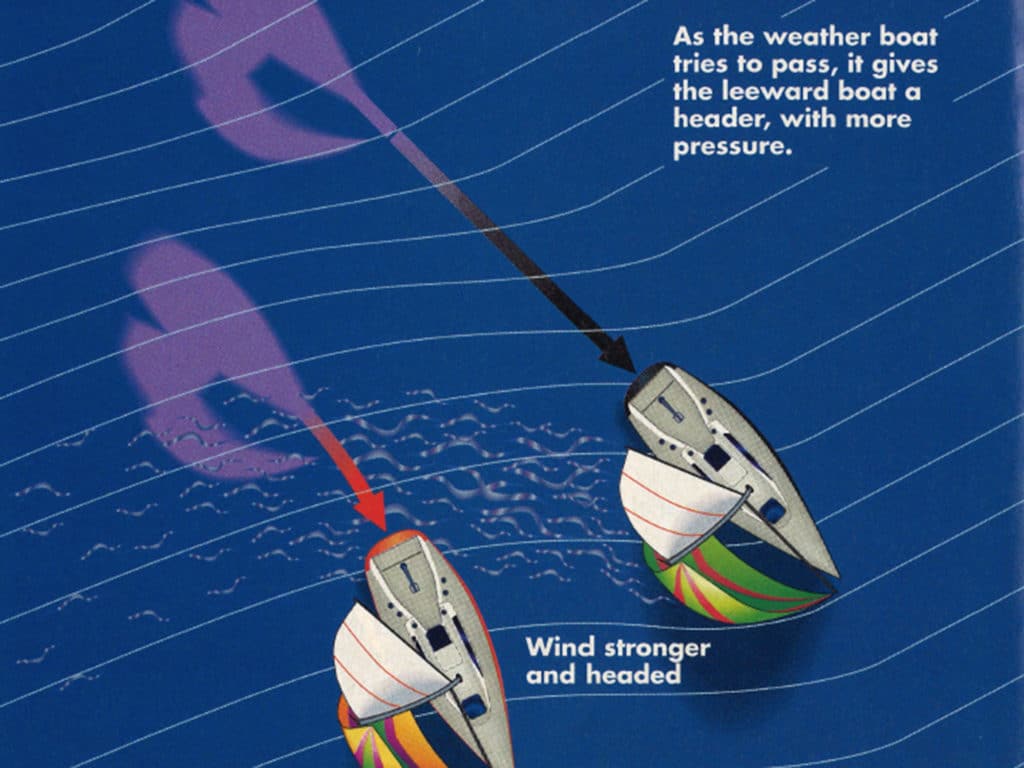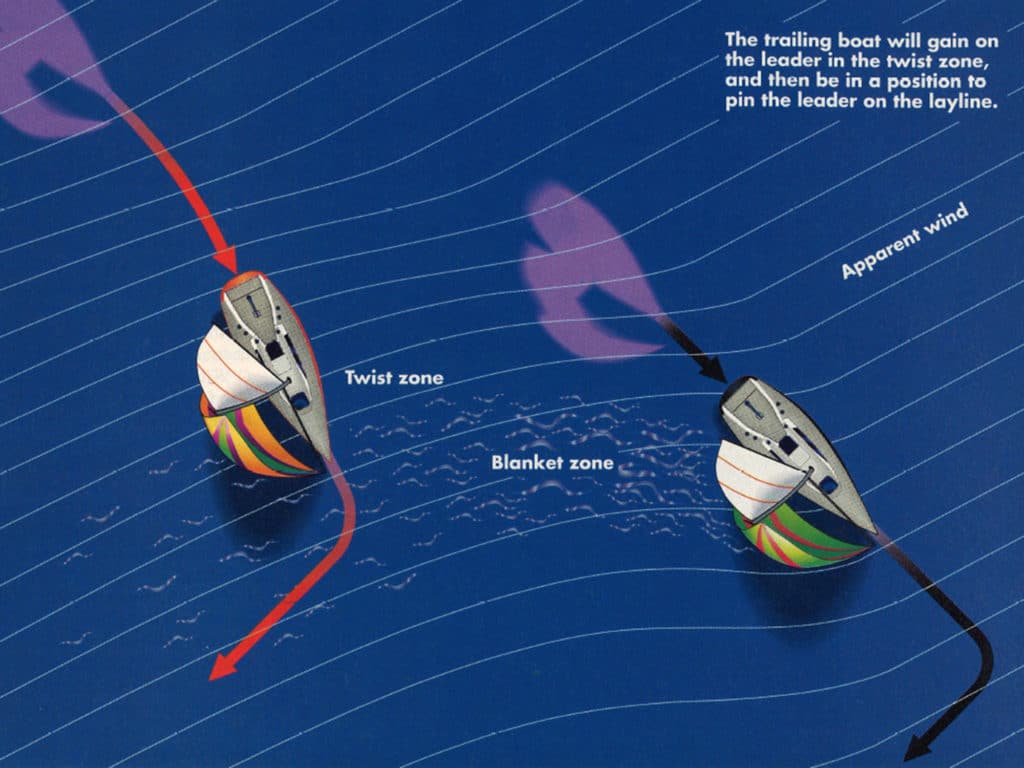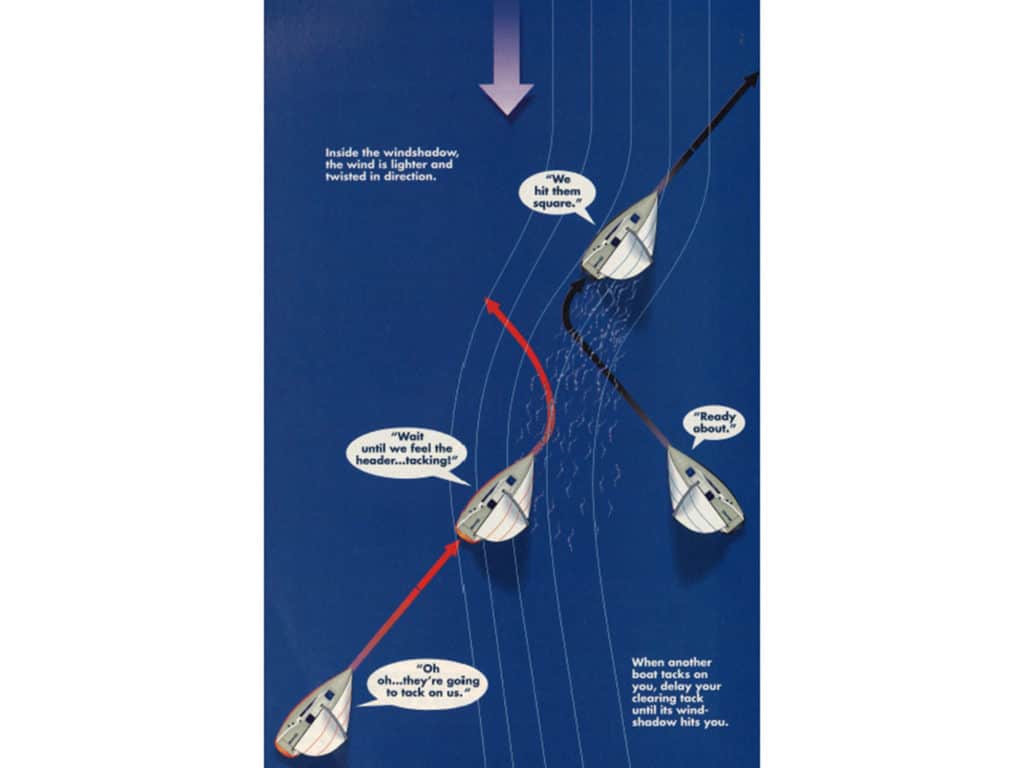
As coach for Team New Zealand, one of the most fascinating learning experiences I had resulted from research into the effects of disturbed air from another boat. As the rigs and hulls we use become more efficient, and as our boats become lighter and accelerate faster, bad air isn’t necessarily the race-ruining dilemma that you might think. In fact, there are times when disturbed air can actually help you!
The windward-leeward courses used in the America’s Cup put a premium on knowing where clear air is and how to keep it. In lighter conditions, the effect of another boat’s wind shadow can reach 8 to 10 boatlengths to leeward. Sailing in this zone of disturbed air is what the trailing boat wants to avoid, and what the leading boat wants to promote.
We all learn about the pain of wind shadows at an early stage of our racing careers. But deciding “when to hold and when to fold” can be the source of great argument on board. This past spring, I started with a clean sheet of paper and set out to re-map the effects of disturbed air, especially downwind in light conditions. To help settle the question of what to do the next time you find yourself in dirty air, consider some of the lessons we learned in the waters off San Diego.
Downwind
Offwind, we learned things that will work in many boats, certainly in lighter hulls with full-battened mains and asymmetric spinnakers. The lessons could also apply to dinghies with spinnakers, and singlehanded boats like Lasers; maybe even to cats and boards. Our early wind-tunnel research showed that, on downwind legs, the flow off an IACC boat’s rig was not as disturbed as expected. Sure, it was slowed down by friction as it passed over the sails and such, but not as much as you might have guessed. Most of what happened to the breeze was a redirection of the flow. With this in mind, we theorized that gains could be made by using this directional change. So, when our boats arrived in San Diego, Team New Zealand set out to test these theories. Soon, we found several areas where we could limit losses, or even gain, by sailing in another boat’s gas downwind!
The first thing we learned was that it’s virtually impossible to pass another boat to weather when running in light air on the same tack. In these conditions, an IACC boat uses a masthead asymmetric spinnaker, with the pole set fairly close to the headstay. The main is trimmed near the comer of the transom, and the apparent wind is well forward of the beam. This is not unlike the way an IMS boat would sail on a jib reach. In these conditions, we could get a windward boat (that was trailing), to slowly roll a slightly slower leeward boat, but only until the windward boat got to a bow-forward position. Then, just before the leeward boat would be blanketed, the speeds would level out, and the two boats would be locked together as long as we wanted to keep sailing. You may remember seeing this happen in one of our semifinal matches against the Japanese. We kept rolling over them from behind, but would then get “stuck,” unable to finish them off.
What was happening, according to our sail design coordinator, Tom Schnackenberg, was that airflow was increased and redirected around the leeward side of the windward boat (see illustration). This allowed the leeward boat to reach a point where it was sailing in a stronger, slightly headed breeze: the leeward boat could either sail lower or faster than its rival. As a result, it was very difficult to pass another boat close to weather when the apparent wind was well forward of the beam.

Learning this made us more confident when leading a race, since we knew how difficult it was to pass. We knew we could always jibe simultaneously to cover, and that our opponent would be hard-pressed to roll us to weather. Conversely, we had to look for other ways to pass when we were behind! Fortunately, the same wind flow helped with that, too.
When trailing another boat, we found that if we positioned ourselves directly astern of the leader, we would often get headed. Until we caught up to within a couple of boatlengths, this allowed us to make better VMG using the twisted wind flow from the boat ahead to sail lower, or, if we preferred, the same height and faster. You can’t pass someone close to leeward because there comes a point where their wind shadow will halt your progress. However, if you’re near the layline, you can position yourself off their leeward quarter. Then you can pin them—when you finally jibe for the mark, you’ll be ahead.
I know there will be some critics thinking that Black Magic was so fast that it just seemed like these things were happening. Let me assure you that we learned about these situations in training, when Russell Coutts was driving one Black Magic, and I was driving the other boat. When we took these ideas to the racecourse against the other teams, they worked.
Remember, though, that this was in lighter conditions, with the pole all the way forward. And it was in boats with a lot of sail, set up very efficiently. This will not be effective in a heavy, underpowered design with tired sails. You can only expect so much, after all.
Also, consider that there’s strength in numbers. When fleet racing, if three or four boats are rolling you on the run, you’d better look for a clear lane. Or if you’re gaining on a group of boats, the wind to leeward of them will not be pristine! Even with only one boat affecting your wind, if your sails collapse, you have lost the battle and need to get away. But in the right boat and the right conditions, you may not have to go looking for clear air as desperately as you used to. Try it in practice, and see what you think.

Upwind
The most common place where we encounter the wind shadow of another boat is on the beat. And, unfortunately, I don’t have any huge news for you on this point of sail. You need to tack away from a boat positioned either on or to weather of your bow, when it is within 6 to 10 boatlengths (the greater distance is in lighter conditions). If you don’t, you’II be going lower and slower than your rival, because the air is slowed and headed in its shadow.
There is one way you can utilize the bad air of others upwind, however. This occurs shortly after a boat tacks on you. As another boat crosses and tacks, your first reaction is probably to get out of there. That’s good, but consider waiting to tack until you feel the header from the other boat’s sails. You’ll be tacking onto a temporary lift that will help your sails fill faster, so you’ll lose less speed.
With Team New Zealand, we also found that the turbulence made by the other boat’s rig created a little upwind “wash,” similar to how the water coming off your transom is sucked along behind the boat. If you tack in this wind wash, there is less downwind airflow against you, as compared to tacking in clear air. All else being equal, that lesser downwind drag means you should gain on the leaders every time they tack on you. On Black Magic, we would tack in this wash, split until we had speed, and then tack back. Our opponent would do the same, and we’d always gain. So, roll up your sleeves and get to work—a little dirty air never hurt anyone, at least not anymore!









